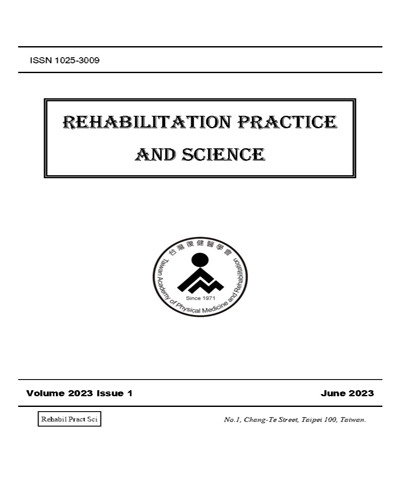
台灣復健醫學雜誌/REHABILITATION PRACTICE AND SCIENCE
臺灣復健醫學會,正常發行
選擇卷期
- 期刊
隨著心臟疾病醫療設備及藥物治療的不斷研發與進步,有助於慢性心衰竭病患存活率的提升,心衰竭伴隨之肌肉病變所造成的肌肉萎縮、肌肉疲勞現象,是造成病患運動不耐受性的重要原因。阻力(肌力)訓練可有效促進肌肉功能,但針對心衰竭病患,在左心室心肌再塑進展與血液動力變化的安全考量上,對於實施的適當性到目前仍受爭議。實證文獻回顧發現,對於穩定心衰竭(紐約心臟協會功能分級Ⅰ~Ⅲ級)病患,建議在提供嚴謹功能評估下,適當提供相關阻力(肌力)訓練計畫,除可以有效提升有氧運動耐受度外,骨骼肌肉的組織化學、代謝及功能上也具顯著的適應效果,阻力訓練進行也未引發左心室功能惡化,甚至可提升左心室射出率。本文經由實證文獻回顧,提供心衰竭阻力(肌力)訓練的臨床計畫指引參考。
- 期刊
目的:識別樹狀關節脂肪瘤於磁振造影上之不同形態表現及相關病灶,並探討其臨床意涵。方法:本研究收集共78個樹狀關節脂肪瘤之案例,並回顧其影像表現及病歷紀錄。其中包括73個位於膝關節及5個肩關節之案例。2個案例經病理檢查確定診斷,其餘76個案例為磁振造影診斷。結果:所有案例於磁振造影上皆表現出典型之滑膜脂肪性增生,其中38%呈現典型之樹枝狀型態,41%為腫塊狀表現,另10%混合此兩種表現。樹狀關節脂肪瘤於膝關節內之相關病灶包括:關節積液(97%)、後十字韌帶損傷(69%)、前十字韌帶損傷(43%)、退行性變化(40%)、骨髓水腫(34%)、半月軟骨損傷(32%)、滑膜囊腫(15%)、內側韌帶損傷(13%)、軟骨破損(12%)、軟骨瘤病(6%)、臏骨半脫位(4%)及圓盤狀半月板(4%),除兩位案例外,所有案例皆伴隨相關病灶;5個肩關節案例之相關病灶包括:旋轉肌撕裂傷(100%)、關節積液(100%)、退行性變化(80%)、肱二頭肌長頭腱鞘炎(40%)及可能之沾黏性關節囊炎(40%)。所有案例之樹狀關節脂肪瘤表現皆為意外發現。當中只有兩位接受關節鏡滑膜切除術,但後續皆有症狀復發之情形。結論:樹狀關節脂肪瘤雖為罕見病灶,其磁振造影上之特有形態表現可提供正確及早期之診斷。本研究之結果顯示關節創傷後或退化性關節炎皆可能導致此病灶之形成。及早的介入治療應有助於關節損傷之復原及避免症狀進展及惡化。
- 期刊
Background: The rating of perceived exertion (RPE), metabolic equivalent (MET) and maximum heart rate (HRmax) at ventilatory threshold (VT) are commonly used methods as physiological parameters for monitoring exercise intensity. However, the appropriate levels of training intensity for obese type 2 diabetic diabetes mellitus (type 2 DM) patients have not been established.Purpose: To examine the parameters in obese Type 2 DM patients at ventilatory threshold, the exercise capacity of obese Type 2 DM patients, and to determine the appropriate levels of exercise intensity for exercise prescription in obese type 2 DM patients was investigated.Methods: Twenty obese type 2 DM patients (body mass index >27) were recruited. The physiological parameters (maximum oxygen uptake, maximum heart rate [or simply HRmax], and RPE at ventilatory threshold) of these patients were measured and compared during the cardiopulmonary exercise test.Results: The mean age of the subjects was 54.3±10.9 years, and the mean body mass index was 30.3±3.7. There was no difference on gender, the maximum oxygen uptake, maximum heart rate, and RPE by gender effect (p>0.05). At ventilatory threshold level, the mean metabolic equivalent was 4.1±0.9, and the mean RPE was 13.0±1.7. The mean heart rate at VT was 117.3±14.5 beats/min, which is corresponded to 70.6±8.3% of the age-predicted HRmax, and the heart rate reserve was 36.3±14.7%.Conclusion: Our results indicate that the appropriate levels of exercise intensity for obese type 2 DM patients are 70% of the age-predicted HRmax, 30-40% of the heart rate reserve, MET of 4, and RPE of 13.
- 期刊
Background and Purpose: A concise measurement tool can be easily accepted by clinicians. The 5-item Barthel Index (BI-5) has only 5 items and thus the potential to be used routinely in clinical settings. However, the minimal detectable change (MDC) and responsiveness of the BI-5 have not been verified sufficiently, limiting the interpretability of the change scores of the BI-5. The purposes of this study were to investigate the MDC and responsiveness of the BI-5 in patients with stroke and to compare the MDC and responsiveness of the BI-5 to those of the original BI.Methods: This study used secondary data analysis. A prior data set (with 56 stroke patients administered the BI twice, 14 days apart) was used to calculate the MDCs of the BI and the BI-5. Another data set (with 226 stroke patients administered the BI on the 14th day and the 90th day post onset) was used to calculate the responsiveness of the BI and that of the BI-5. Responsiveness indices included group-level responsiveness (i.e., effect size d, standardized response mean, SRM and paired t test) and individual-level responsiveness (i.e., the difference in number of patients whose change scores on the BI and BI-5 exceeded the respective MDC, and the difference in value of MDC ratio).Results: The MDCs (MDC%) of the BI and BI-5 were 4.3 (28.8%) and 3.1 (41.1%), respectively. The group-level responsiveness of the BI and that of the BI-5 were both large (both d and SRM were more than 0.8). The mean differences of the BI and the BI-5 between two measurements were significant. In individual-level responsiveness, the number of patients administered the BI having change scores exceeding the MDC was greater than that of those administered the BI-5 (155 vs. 141). However, the difference was not statistically significant. The value of the MDC Ratio of the BI was also significantly higher than that of the BI-5.Conclusion: The group-level responsiveness of the BI-5 was good. However, the random measurement error of the BI-5 was larger than that of the original BI, and the individual-level responsiveness of the BI-5 was slightly less than that of the BI. Thus, we recommend that given sufficient time for assessment, clinicians and researchers should use the original BI rather than the BI-5 to sufficiently show the change of ADL function in stroke patients. The results of this study can help clinicians and researchers interpret patients' change scores and select an appropriate ADL measure.
- 期刊
糖尿病人罹患糖尿病視網膜病變(diabetic retinopathy)已證實與心臟自主神經功能異常有關。無論是次大運動或極限運動,異常心跳回復率(heart rate recovery,HRR)是一種容易被檢測,代表心臟自主神經功能下降的指標。臨床上,六分鐘走路測試(6-minute walk test,6MWT)屬於一種次大運動且更貼近日常活動能力,各種類型病人皆可從事此測試,且不需要複雜器材。本篇研究目的是要探討第二型糖尿病人在六分鐘走路測試後心跳回復率與罹患糖尿病視網膜病變的關係。共有60位第二型糖尿病人完成本研究。依據六分鐘走路測試後心跳回復率高低分做四組進行探討。結果發現心跳回復率較低組別休息時心率顯著地較大、心率增加量較少,且六分鐘走路測試距離也相對較短。整體第二型糖尿病受試者中,在心跳回復率較低、心臟自主神經功能較差的組別,有較低的運動能力表現與可能有相對較高罹患糖尿病視網膜病變機率的趨勢。六分鐘走路測試後心跳回復率在臨床上容易被執行與推廣,以往並未將此測試應用在第二型糖尿病人心臟自主神經功能的相關探討。未來仍需要更多研究加以證明六分鐘走路測試後心跳回復率,可以做為檢測第二型糖尿病人的心臟自主神經功能與罹患糖尿病視網膜病變的指標,並可進一步應用此測試評估病人接受復健訓練之後的成效。
- 期刊
旋轉肌腱修補之術後的復健方式目前仍無明確標準,尤其以急性期的復健更是見解分歧。本研究的目的在於探討此類病人術前衛教及術後急性期的復健對預後之成效,希望能建立最合適的復健指引。本研究採前瞻性方法,三個月內蒐集20名接受旋轉肌腱修補術之病人。復健內容包括手術前的衛教、手術後的擺位、被動關節活動及連續被動關節活動機(continuous passive motion)使用等,並統計病人住院天數,以及滿意程度。手術後三到五個月追蹤病人的疼痛指數(visual analogue scale)、日常生活功能(activities of daily living)等,並安排超音波檢查評估肌腱完整程度。結果顯示在病人之疼痛指數,手術前為5.65±1.39,手術後在訪問時為1.76±0.85,平均下降幅度為3.81±1.50;在肩膀日常生活功能方面,大部分的病人均有明顯改善,僅有兩位患者出現關節僵硬,功能下降之情況。超音波的追蹤發現兩名患者出現旋轉肌再斷裂(re-tear)的現象。在住院天數方面,復健介入後住院天數平均下降將近一天,前來復健科門診治療比率則和介入前無差異;病人整體滿意度高。本研究顯示早期介入能讓病人有更好的住院滿意度,減少住院天數,且病人日常生活功能有顯著改善,但對於術後的肌腱癒合無明顯影響。
- 期刊
股神經病變相較於其它單一神經病變是比較少見的。我們報告一名53歲男性,有心血管疾病且服用抗凝血劑已有八年的時間,因髂腰肌出血,進而壓迫股神經及腰神經叢引起左下肢無力及疼痛。除此之外,也對股神經的解剖與病理生理學、股神經病變的臨床表現、診斷工具、治療及預後做回顧整理。
- 期刊
威廉氏症候群(Williams-Beuren's syndrome)是一染色體疾病,為第七對染色體的長臂(deletion 7q11.23)缺失,而導致一個或多個基因功能異常,其中以彈力蛋白(elastin)基因與先天性心臟病等臨床症狀有關。常伴隨心血管疾病、臉部異常、牙齒問題、智力與認知發展遲緩、空間認知及動作發展的能力不佳。然而粗大動作之表現較少為學者注意,因此,本篇病例報告除了描述治療之經驗外,也強調粗大動作在早期療育介入後所看到之成效。此經過早期介入之威廉氏症兒童,自7個月大時經早期療育評估後即開始接受療育,經過20個月的訓練後,個案在動作功能方面皆有進步,改善其生活功能,也增進親子間的關係互動,因此早期療育介入可改善遲緩兒童的動作功能,提升日常生活活動上的獨立並增進人際社交互動,也可增加兒童及家長間良好的親子關係。

